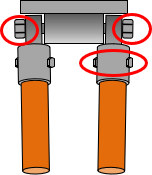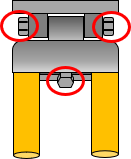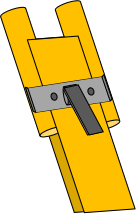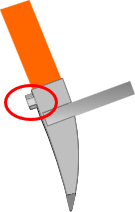2. Tripod
A tripod provides a stable base for various instruments. Loose or missing hardware can adversely affect measurements.
a. Leg Attachment
Legs attached with screws, bolts, or rivets to brackets which in turn attach to the tripod head with bolts, Figure B-1. Check to make sure screws and bolts are tight. If rivets are used and they are loose, they may need to be drilled out and replaced.
 |
 |
| (a) | (b) |
| Figure B-1 Leg and Head Attachments |
|
b. Extension Locks
Locks should secure extended legs firmly for all equipment used. A lock holding under the weight of an automatic level may fail for a total station. The failure may be slow affecting the instrument level, or quick resulting in equipment damage.
Locks types are generally screw or toggle, Figure B-2. Toggle locks can be adjusted as they loosen over time. Screw locks on older tripods may eventually not tighten sufficiently and many cannot be adjusted. If that's the case, replace the tripod.
 |
 |
| (a) Screw | (b) Toggle |
| Figure B-2 Extension Locks |
|
Locks on a tripod stored in a warm environment and used in cold conditions without acclimation may fail due to material contraction. After use in the cold, locks should be loosened before placing a tripod in warm storage. If not, material expansion may cause leg or lock deformation which may not be repairable.
c. Tripod Shoes
A tripod shoe attaches to a leg using screws, bolts, or rivets, Figure B-3.
 |
| Figure B-3 Tripod Shoe |
Tighten screws or bolts to prevent shoe wobble. Loose rivets may need to be drilled out and replaced.
d. Overall inspection
Material has particular characteristics affecting tripod performance. Things to inspect:
- Wood. Although largely fallen out of fashion because of their weight, many wooden tripods are still in use. The wood, especially at the extension locks can become flattened with repeated lock use. Chipped or cracked paint can allow moisture entry affecting smooth extension action.
- Aluminum. Aluminum is lighter than wood and less moisture susceptible. The material, however, can be dented or deformed. Aluminum tripods typically use riveted construction; loose rivets may or may not be able to be replaced.
- Plastic or fiberglass. Also lighter and more moisture resistant than wood, plastic and fiberglass are additionally non-conductive materials. Although they won't dent or permanently deform like aluminum, they can crack if manhandled roughly or hardware is over-tightened. Riveted construction has the same loose hardware issues as aluminum tripods.
With the tripod legs firmly planted and extension locks engaged, grasp the head and twist to check for stability. Wobble or deflection means a questionable instrument platform. As a tripod ages, it can wear to the point that it cannot provide a stable instrument platform, regardless how much its hardware is tightened. When that happens, instead of trying patchwork solutions, replace the tripod. A new good quality tripod is relatively inexpensive and cheap insurance considering its importance.